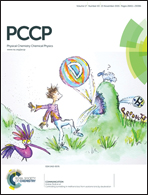Nitrogen content and morphology dependent field emission properties of nitrogen-doped SiC nanowires and density functional calculations†
Abstract
Nitrogen-doped SiC nanowires (N-doped SiC NWs) with a nitrogen content from 0.975 wt% to 2.265 wt% have been synthesized via a one-step chemical vapor reaction (CVR), where melamine served as both the carbon and nitrogen source. Interestingly, the morphology of the products changed from slightly curled to very curled with crowding together with the increase of N dopants, which was interpreted reasonably by the proposed N-doping growth model of SiC NWs. In addition, according to the electronic structure calculation results, the band gap is narrowed progressively with the increase of N content, which greatly enhances the field emission (FE) properties. However, the experimental results of the FE measurements substantiate that only when the N content takes an optimal value can the N-doped SiC NWs act as candidates for field emitters with very low turn-on fields (Eto) of 1.5 V μm−1 and threshold fields (Ethr) of 4 V μm−1. On the basis of the aforementioned phenomenon, a universal cooperativity mechanism was put forward to explain the effect of the N content and morphology on the FE properties of the N-doped SiC NWs.


 Please wait while we load your content...
Please wait while we load your content...